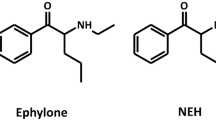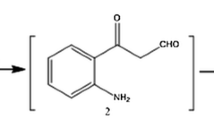Abstract
Purpose
The metabolism of bendamustine (BM) hydrochloride, a bifunctional alkylator containing a heterocyclic ring, was investigated in vitro and in vivo for identification of cytochromes P450 (CYP) involved in the formation of two phase I metabolites, structural confirmation of these previously unidentified metabolites and assessment of their cytotoxic effect in relation to the parent compound.
Methods
Potential metabolites of BM were synthesized and structurally characterized by nuclear magnetic resonance (NMR) and liquid chromatography-mass spectrometry (LC-MS) analysis. In vitro metabolism of BM hydrochloride in human hepatic microsomes was conducted to identify the CYP450 isoenzymes involved in the oxidative metabolism of BM. Samples from cancer patients after treatment with BM hydrochloride and microsomal preparations were analyzed by LC-MS and HPLC with fluorescence detection. The cytotoxic effect of the metabolites was analyzed in several lymphoma cell lines and peripheral blood lymphocytes and compared with that of the parent compound using an MTT assay.
Results
LC-MS as well as HPLC with fluorescence detection revealed hydroxylation of the methylene carbon at the C-4 position of the butanoic acid side chain and N-demethylation of the benzimidazole skeleton as the main metabolic pathways in human liver microsomes. Isoform-specific chemical inhibitors and correlation analysis pointed to CYP1A2 as the prominent enzyme in BM oxidation. The rate of formation for both metabolites correlated (r = 0.931 and 0.933) with the activity of CYP1A2 and there were no other notable correlations with any of the other CYPs. In addition, both metabolites were identified in plasma, urine, and bile samples from cancer patients under BM hydrochloride therapy as shown by comparison with chromatograms obtained from the authentic reference standards. Cytotoxic activity observed for γ-hydroxy BM was approximately equivalent to that obtained for the parental compound BM. N-demethyl BM displays five to tenfold less cytotoxic activity than BM.
Conclusion
The results indicate that CYP1A2-catalyzed N-dealkylation and gamma hydroxylation are the major routes for BM phase I metabolism producing two metabolites less or similarly toxic than the parent compound. In contrast to the metabolic pathways of the structurally related chlorambucil, no β-oxidation of the butanoic acid side chain leading to enhanced toxicity was detected for BM.








Similar content being viewed by others
References
Bleyl AD, Zschuppe E, Steglich J, Brandl HG, Justus J, Nüsslein HG (2001) Complete remission of a long lasting Chemotherapy refractory secondarily high-grade B-cell lymphoma after therapy with bendamustine and CD 20-antibody (Rituximab). Tumordiagn Ther 22:15–19
Bremer K, Roth W (1996) Bendamustine, a low toxic nitrogen-mustard derivative with high efficacy in malignant lymphomas. Tumordiagn Ther 17:1–6
Cohen P, Cheson B, Friedberg J, Robinson KS, Foran J, Fayad L, Tulpule A, Bessodo A, van der Jagt R, Suster S, Multani PS (2005) The novel alkylator, treanda™ (Bendamustine HCl), is active in both rituximab-refractory and rituximab-sensitive relapsed indolent NHL with acceptable toxicity In: Proceedings of the 41th ASCO annual meeting, OR, USA, p 16S (Abstract 6564)
Hartvig P, Simonsson B, Öberg G, Wallin I, Ehrsson H (1988) Inter- and intraindividual differences in oral chlorambucil pharmacokinetics. Eur J Clin Pharmacol 35:551–554
Heider A, Niederle N (2001) Efficacy and toxicity of bendamustine in patients with relapsed low-grade non-hodgkin’s lymphomas. Anticancer Drugs 12:725–729
Hoffken K, Merkle K, Schonfelder M, Anger G, Brandtner M, Ridwelski K, Seeber S (1998) Bendamustine as salvage treatment in patients with advanced progressive breast cancer: a phase II study. J Cancer Res Clin Oncol 124:627–632
Lee FY, Coe P, Workman P (1986) Pharmacokinetic basis for the comparative antitumour activity and toxicity of chlorambucil, phenylacetic acid mustard and beta, beta-difluorochlorambucil (CB 7103) in mice. Cancer Chemother Pharmacol 17:21–29
Leoni LM, Bailey B, Reifert J, Niemeyer C, Bendall H, Dauffenbach L, Kerfoot C (2004) In vitro and ex vivo activity of sdx-105 (bendamustine) in drug-resistant lymphoma cells. In: Proceedings of the 95th AACR Annual Meeting, OR, USA, p 278 (Abstract 1215)
McLean A, Woods RL, Catovsky D, Farmer P (1979) Pharmacokinetics and metabolism of chlorambucil in patients with malignant disease. Cancer Treat Rev 6(Suppl):33–42
Ozegowski W, Krebs D (1963) w-[Bis-(b-chloräthyl)-amino-benzimidazolyl-(2)]-propion- bzw. -buttersäuren als potentielle cytostatika. J Prakt Chem 20:178–186
Preiss R, Matthias M, Merkle K (1995) Pharmacological and clinical data of bendamustine. In: Moraes M, Brentani R, Bevilacqua R (eds) Proceedings of the 17th International cancer congress. Monduzzi Editore, Bologna, Rio de Janeiro, pp 1637–1640
Preiss R, Sohr R, Matthias M, Brockmann B, Huller H (1985) The pharmacokinetics of bendamustine (cytostasane) in humans. Pharmazie 40:782–784
Rahn AN, Schilcher RB, Adamietz IA, Mose S, Bormeth SB, Böttcher HD (2001) Palliative radiochemotherapie mit bendamustin bei fortgeschrittenen tumorrezidiven im HNO-bereich. Strahlenther Onkol 177:189–194
Ruffert K, Jann H, Syrbe G (1989) Cytostasan (bendamustine) as an alternative therapeutic approach to treat malignant non-hodgkin’s lymphoma. Z Klin Med 44:671–674
Silvennoinen R, Malminiemi K, Malminiemi O, Seppälä E, Vilpo J (2000) Pharmacokinetics of chlorambucil in patients with chronic lymphocytic leukaemia: comparison of different days, cycles and doses. Pharmacol Toxicol 87:223–228
Strumberg D, Harstrick A, Doll K, Hoffmann B, Seeber S (1996) Bendamustine hydrochloride activity against doxorubicin-resistant human breast carcinoma cell lines. Anticancer Drugs 7:415–421
Teichert J, Sohr R, Baumann F, Hennig L, Merkle K, Caca K, Preiss R (2005) Synthesis and characterization of some new phase II metabolites of the alkylator bendamustine and their identification in human bile, urine, and plasma from patients with cholangiocarcinoma. Drug Metab Dispos 33:984–992
Weber H, Amlacher R, Preiss R, Hoffmann H (1991) Pharmacokinetics of bendamustin (Cytostasan) in B6D2F1-mice. Pharmazie 46:589–591
Zulkowski K, Kath R, Semrau R, Merkle K, Hoffken K (2002) Regression of brain metastases from breast carcinoma after chemotherapy with bendamustine. J Cancer Res Clin Oncol 128:111–113
Author information
Authors and Affiliations
Corresponding author
Rights and permissions
About this article
Cite this article
Teichert, J., Baumann, F., Chao, Q. et al. Characterization of two phase I metabolites of bendamustine in human liver microsomes and in cancer patients treated with bendamustine hydrochloride. Cancer Chemother Pharmacol 59, 759–770 (2007). https://doi.org/10.1007/s00280-006-0331-5
Received:
Accepted:
Published:
Issue Date:
DOI: https://doi.org/10.1007/s00280-006-0331-5




